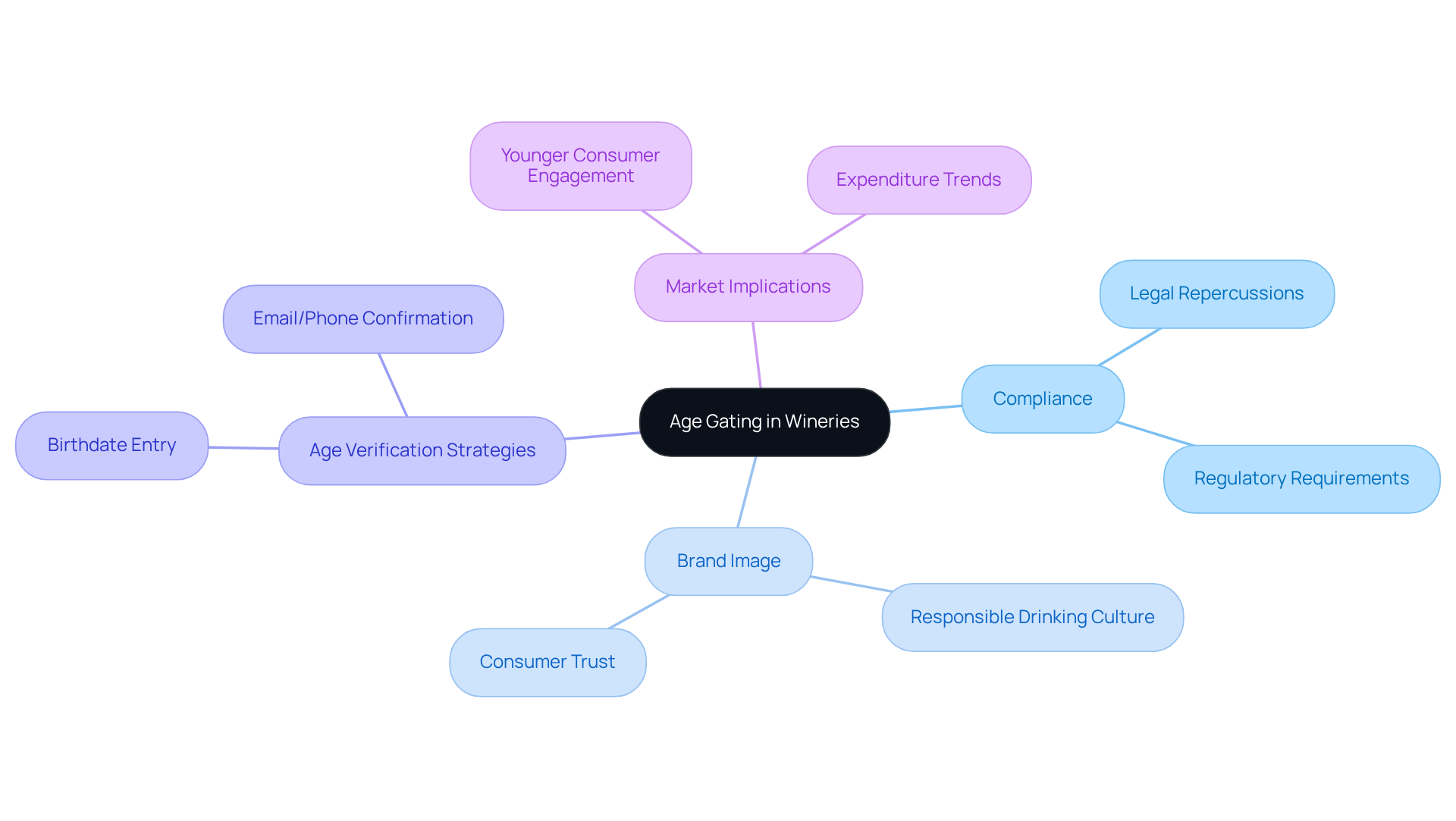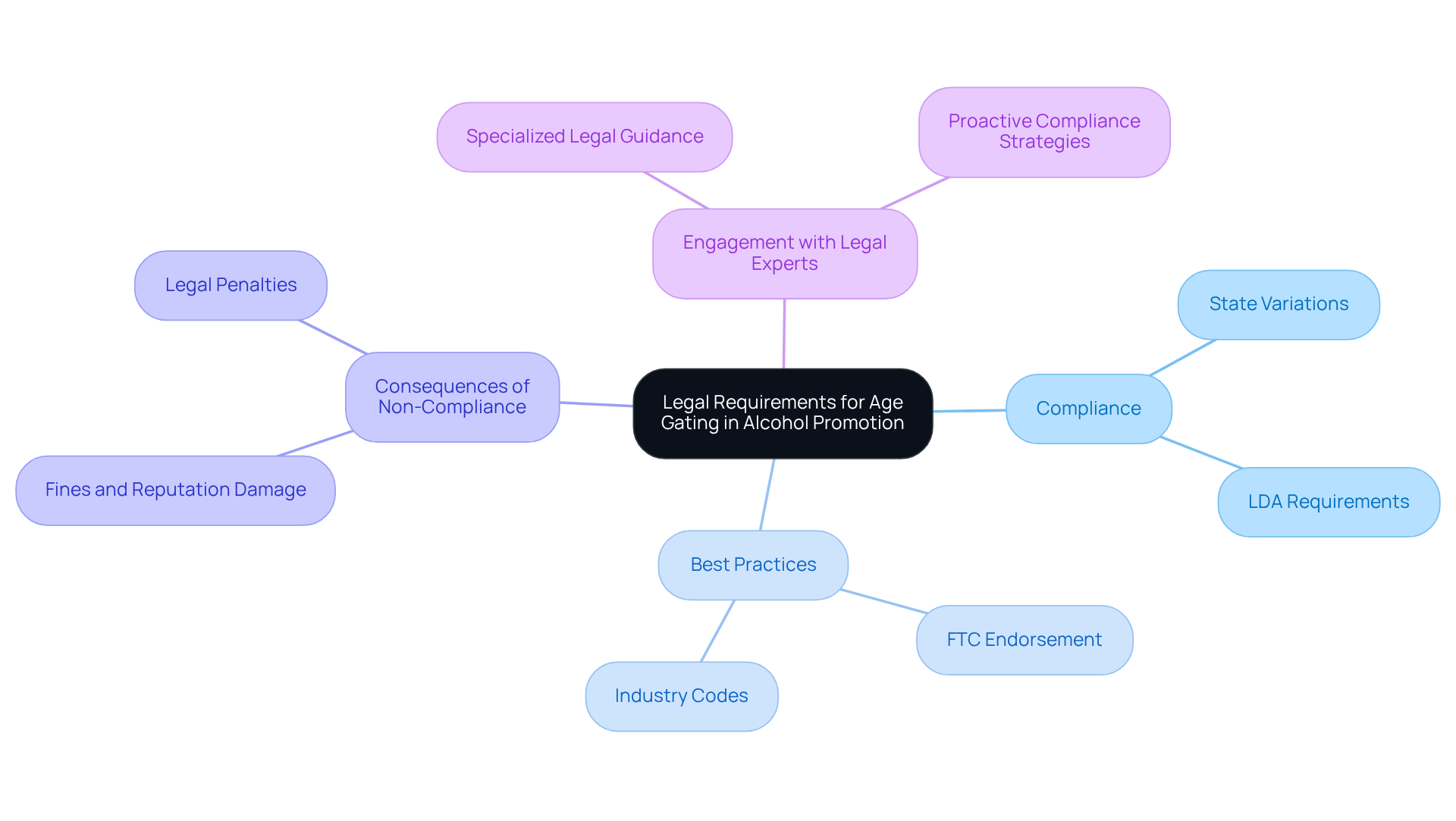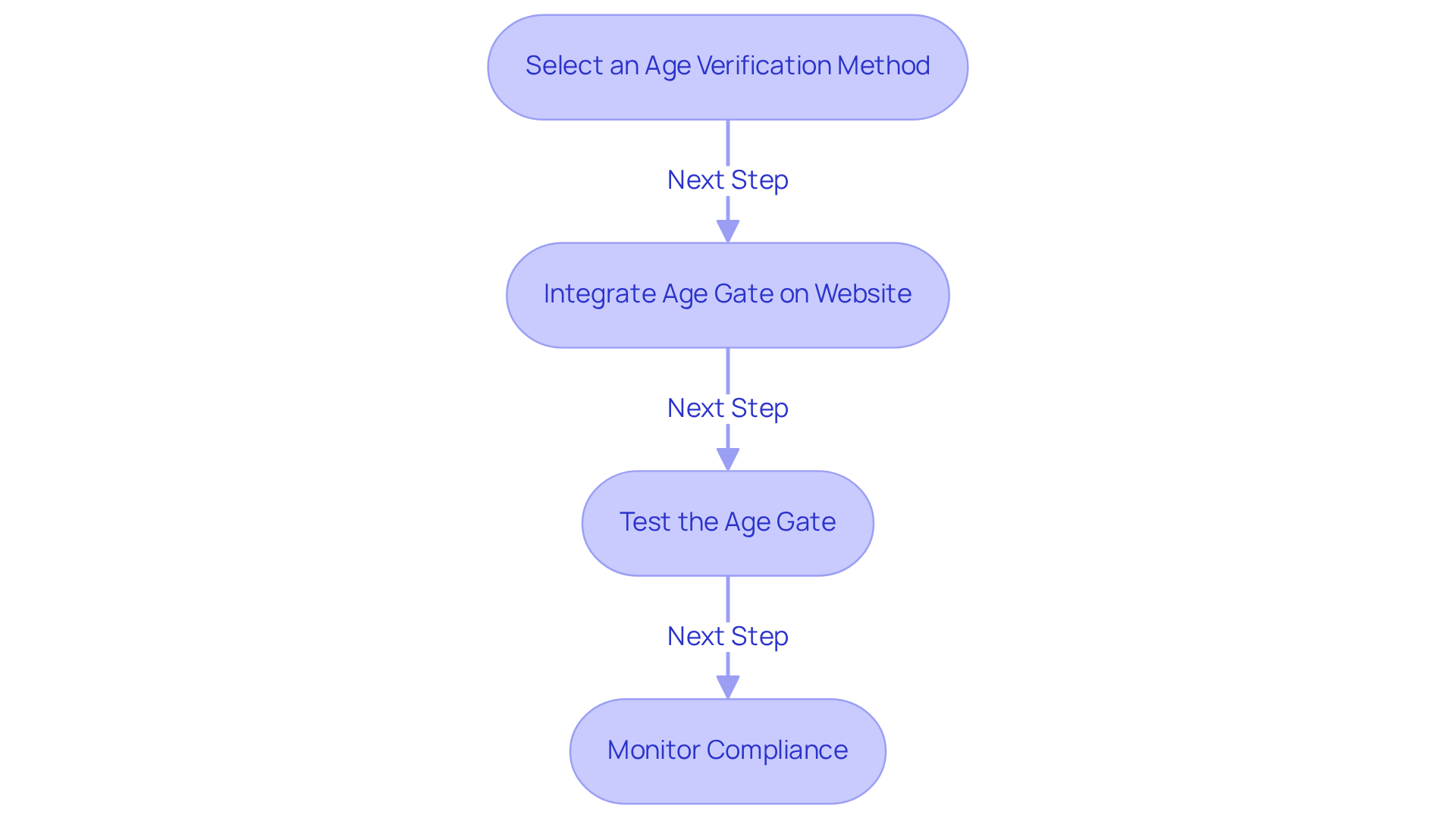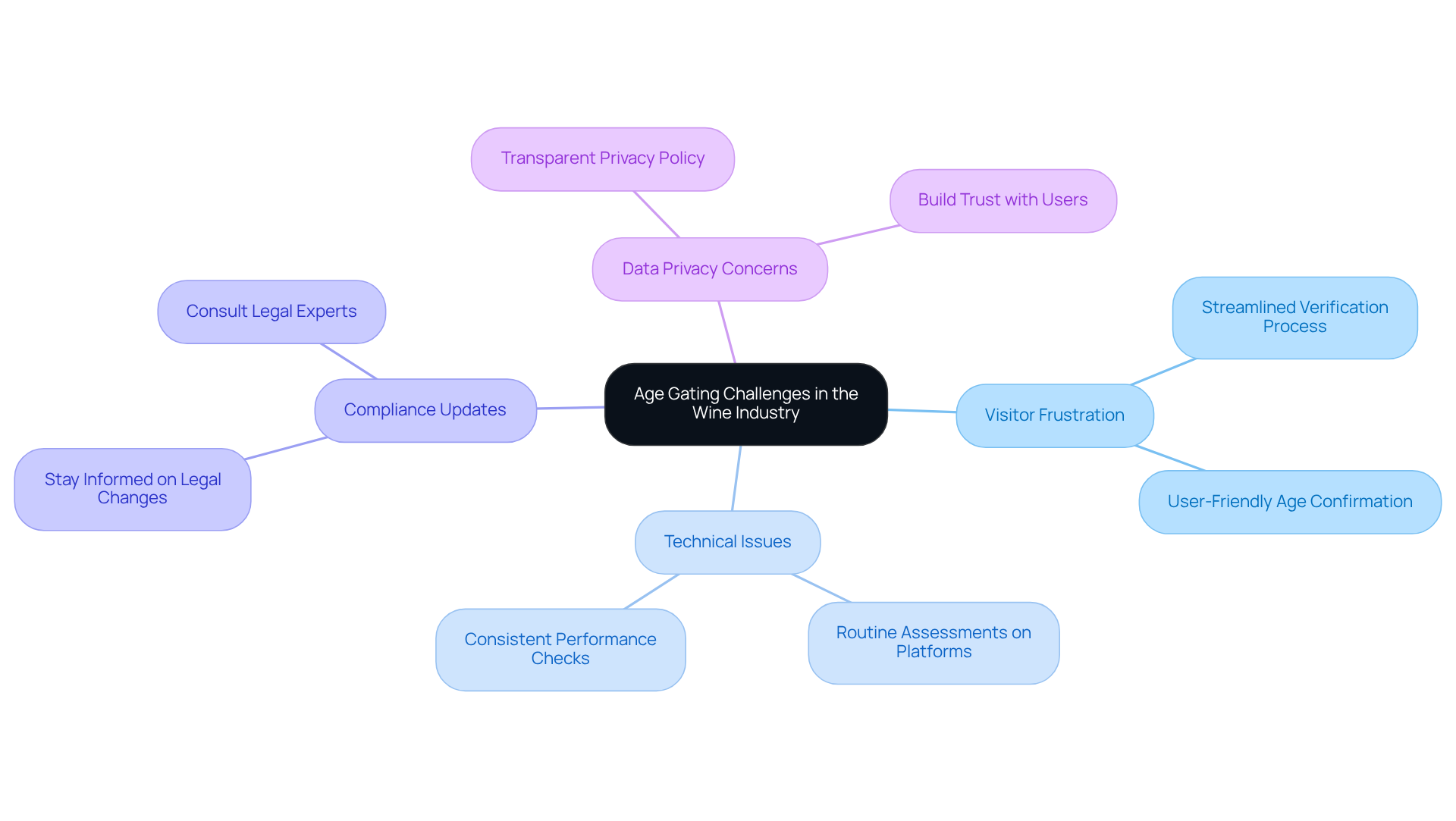Overview
Implementing age-gated strategies is not merely a regulatory necessity for wineries; it is an essential step towards fostering responsible drinking among consumers. Effective age verification safeguards against legal repercussions and simultaneously enhances brand image and consumer trust. These factors are critical for achieving long-term success in a competitive market. By prioritizing compliance and responsibility, wineries can position themselves as leaders in the industry, demonstrating their commitment to both legal standards and consumer welfare.
Introduction
The wine industry is navigating a complex landscape where compliance and consumer trust are paramount. Age gating emerges as a crucial strategy for wineries, enabling them to adhere to legal requirements while promoting responsible drinking and enhancing their brand image. As the market evolves and younger consumers become increasingly engaged, the pressing question arises: how can wineries effectively implement age verification practices that resonate with their audience while ensuring compliance?
This article delves into the significance of age gating for wineries, exploring best practices and addressing the challenges that accompany it. Ultimately, it guides producers toward a successful and responsible marketing approach.
Define Age Gating and Its Importance for Wineries
The practice of age gating is critical as it restricts access to specific content or products based on the user's age. For vineyards, this strategy is essential to comply with regulations prohibiting alcohol sales to minors. Not only does this method protect against legal repercussions, but it also fosters a culture of responsible drinking—an imperative for family-owned establishments striving for longevity. By clearly indicating that their products are intended for adults, producers can significantly enhance their brand image and build consumer trust, aligning with Enocap's mission to craft compelling narratives that drive sales and establish sustainable direct-to-consumer channels.
Effective age gated strategies can include requiring users to verify their age through straightforward prompts, such as entering a birthdate or confirming their age via email or phone number. These measures not only safeguard the interests of the establishment but also reinforce the brand's commitment to ethical practices, ultimately strengthening the connection with their target audience. This dedication to responsible marketing is vital for maintaining a positive reputation in a fiercely competitive market.
As younger consumers increasingly engage with the wine market, implementing robust age verification can help producers attract this demographic while ensuring compliance. For instance, recent statistics indicate that younger buyers' average expenditure on wine has risen significantly, suggesting an expanding market that producers can responsibly access. By adopting age gated strategies, wineries can position themselves as trustworthy brands prioritizing consumer safety and responsible drinking, thereby enhancing loyalty and fostering growth within the wine industry.

Understand Legal Requirements for Age Gating in Alcohol Promotion
Wineries are confronted with the intricate landscape of regulations surrounding age gated verification, a challenge that varies significantly from state to state. While age gated measures are not legally required, they are endorsed by industry codes and the Federal Trade Commission (FTC) as best practices. These regulations necessitate that any marketing or promotional content related to alcohol incorporates methods to confirm the age of individuals, effectively thwarting underage access. For example, websites must implement age gated restrictions that require users to input their date of birth to verify their drinking age before accessing content or making purchases.
Staying abreast of local regulations is crucial, as non-compliance can result in substantial fines—often reaching thousands of dollars—and can severely damage a vineyard's reputation. Engaging with legal experts who specialize in alcohol marketing is essential for clarifying these requirements and ensuring compliance with state-specific laws, particularly as the alcohol advertising landscape continues to evolve. This proactive approach not only safeguards your business but also reinforces your commitment to responsible marketing practices.

Implement Age Gating on Your Winery's Digital Platforms
To effectively implement age gating on your winery's digital platforms, it is essential to follow these strategic steps:
-
Select an Age Verification Method: Choose between a straightforward age gate, such as a pop-up prompting individuals to confirm their age, or a more comprehensive system that requires individuals to enter their birthdate or upload identification. Research indicates that simpler methods, like self-attestation, can enhance user experience while still meeting compliance needs. Notably, the FTC's 2014 Report suggested that consumers accessing the website of an alcoholic beverage producer must provide their date of birth to ensure they are age gated, instead of just verifying that they are of permitted drinking age.
-
Integrate the age gated feature on your website by utilizing plugins or custom coding to embed the age verification prominently on your homepage and any pages showcasing alcohol products. Ensure that the gate is intuitive and does not disrupt the browsing experience; a seamless process can significantly reduce cart abandonment rates. For instance, Drizly reported a 20% reduction in order cancellations attributed to their clear and effective age verification process.
-
Test the Age Gate: Conduct thorough testing of the age gate across various devices and browsers before launching. This ensures functionality and allows for adjustments that enhance user experience, which is critical for maintaining customer engagement.
-
Monitor Compliance: Regularly evaluate your age gated system to ensure it aligns with changing regulatory requirements. Staying updated on regulations and adjusting your methods accordingly is essential to avoid potential penalties, such as fines ranging from $500 to $1,500 per violation under TCPA regulations, while also maintaining ethical marketing practices.
Implementing these strategies not only safeguards your winery against legal issues but also fosters trust with consumers, ultimately contributing to a more successful online presence. It is crucial to adhere to the codes adopted by the Brewers Association, Beer Institute, Wine Institute, and Distilled Spirits Council, which necessitate age verification for compliance.

Address Challenges and Solutions in Age Gating Implementation
Implementing age gated measures in the wine industry presents several challenges; however, these can be effectively managed through targeted strategies that enhance customer experience and compliance.
-
Visitor Frustration: Many individuals perceive age gates as cumbersome. To alleviate this, streamline the age gated verification process by utilizing a simple checkbox or dropdown menu for confirming age. This approach minimizes friction and enhances the overall experience. With older adults becoming increasingly significant in the eCommerce market—those aged 65 and above are expected to outnumber children under 18 by 2035—it is essential to ensure that the verification process is age gated and user-friendly.
-
Technical Issues: Age verification systems may not perform consistently across all devices. Conducting routine assessments on different platforms is crucial to identify and rectify any technical issues, ensuring a seamless age gated experience for all users. Older shoppers, who typically engage in thorough research before making purchases, will appreciate a reliable system that functions smoothly.
-
Compliance Updates: Age verification laws are subject to change. To maintain compliance, stay informed about legal developments by subscribing to industry newsletters or consulting with legal experts. This proactive approach ensures that your age gated practices align with current regulations.
-
Data Privacy Concerns: Users may hesitate to share personal information due to privacy concerns. Clearly communicating your privacy policy and how their data will be utilized fosters transparency, builds trust, and encourages users to engage confidently with your site. Notably, 86% of online seniors spend at least six hours a day online, underscoring the importance of establishing trust with this demographic.
By addressing these challenges with effective solutions, wineries can enhance their age gated processes, ultimately leading to improved customer satisfaction and compliance.

Conclusion
Implementing age gating strategies is not merely a regulatory necessity for wineries; it is a crucial element in cultivating a responsible and trustworthy brand image. By ensuring that only legally permitted consumers can access their products, wineries not only protect themselves from legal repercussions but also foster a culture of responsible drinking. This commitment to ethical practices enhances consumer trust and aligns with the broader mission of promoting sustainable direct-to-consumer channels.
Key insights discussed throughout this article highlight the importance of age verification, the legal landscape surrounding it, and practical steps for effective implementation. Strategies such as:
- Selecting user-friendly verification methods
- Seamlessly integrating age gates on digital platforms
- Proactively monitoring compliance
are essential for navigating the complexities of age gating. Moreover, addressing challenges like visitor frustration and data privacy concerns through targeted solutions can significantly enhance customer satisfaction and brand loyalty.
Ultimately, age gating transcends being a mere regulatory checkbox; it embodies a winery's dedication to responsible marketing and consumer safety. As the wine market continues to evolve, particularly with the increasing engagement of younger consumers, the significance of robust age verification practices cannot be overstated. Wineries are encouraged to embrace these strategies not only to comply with legal requirements but also to position themselves as leaders in responsible alcohol marketing, paving the way for sustainable growth and a positive reputation in the industry.
Frequently Asked Questions
What is age gating and why is it important for wineries?
Age gating is the practice of restricting access to content or products based on the user's age. For wineries, it is crucial to comply with regulations that prohibit alcohol sales to minors, protect against legal repercussions, and promote a culture of responsible drinking.
How does age gating benefit a winery's brand image?
By clearly indicating that their products are intended for adults, wineries can enhance their brand image and build consumer trust. This aligns with their mission to create compelling narratives and establish sustainable direct-to-consumer channels.
What are some effective age gating strategies for wineries?
Effective age gating strategies can include requiring users to verify their age by entering a birthdate or confirming their age via email or phone number. These measures help safeguard the establishment's interests and reinforce their commitment to ethical practices.
Why is responsible marketing important for wineries?
Responsible marketing is vital for maintaining a positive reputation in a competitive market. It strengthens the connection with the target audience and demonstrates a winery's dedication to consumer safety and responsible drinking.
How can age verification help wineries attract younger consumers?
Implementing robust age verification allows wineries to engage with younger consumers while ensuring compliance with legal regulations. Statistics show that younger buyers' average expenditure on wine has increased, indicating a growing market that wineries can responsibly tap into.
What is the impact of age gating on consumer loyalty and growth in the wine industry?
By adopting age gating strategies, wineries can position themselves as trustworthy brands that prioritize consumer safety and responsible drinking, which can enhance customer loyalty and foster growth within the wine industry.




